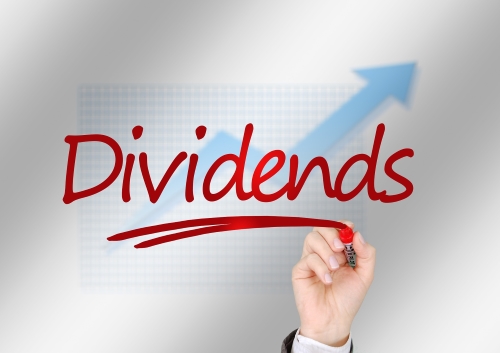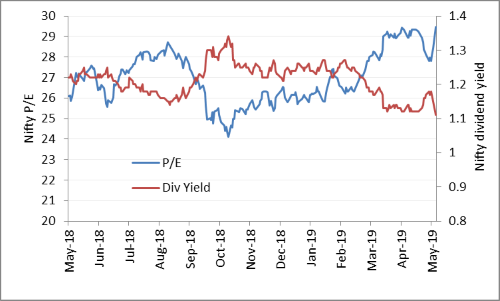 (Image source: Image by Gerd Altmann from Pixabay)
(Image source: Image by Gerd Altmann from Pixabay)
"If you want the recipe for getting rich in the stock market, here it is: Find stocks with above-average appreciation potential and safe and growing dividends, and buy them at attractive prices."-Charles B. Carlson
Mutual funds have further simplified this job by offering you dividend yield funds. According to SEBI categorisation norms, any equity mutual fund scheme predominantly investing in dividend yielding stocks is classified as a dividend yield fund.
In practice, dividend yield funds not only invest in dividend yielding stocks, but they try to maximise the dividend yield by buying good dividend paying companies at cheap valuations.
But what dividend yield exactly means?
In layman terms it means, the return you earn by way of dividend in a year.

Dividend yield falls when:
In some cases, the vice-a-versa is true.
Similarly, one can calculate the dividend yield for the entire index. By aggregating dividends of index constituents and dividing this aggregate by the index value.
Chart 1: PE Expansion making dividend yield unattractive

Data as on May 20, 2019
(Source: NSE)
At present, the dividend yield of Nifty 50 index is just 1.11%. In fact, your balance in the savings bank account may fetch you higher returns. So, why you should even look at the Nifty dividend yield?
That's because fund managers do.
In most cases, the dividend yield of country's leading index serves as a guiding force to measure the attractiveness of dividend yield of individual stocks.
Moreover, you can determine the attractiveness of a stock's dividend yield by comparing the yield with the risk-free coupon on G-sec bonds When it comes to dividend income, it is deemed better when the difference in the long-term g-sec yields and stock's dividend yield is lower. .
Nonetheless, there isn't any hard and fast rule to decide on the attractiveness of a stock and its dividend yield.
Some typical traits of companies fetching higher dividend yields:
-
They are stable or low growth companies
-
Huge cash surplus but the management has no clue about how to utilise it effectively
-
Or possibly they don't need much cash to grow business
-
Promoter holds majority of stake and wishes to earn higher dividend income
You might wonder why you should invest in low growth companies?
Here're a few more traits which are often inconspicuous and thus go unnoticed frequently
-
Low growth companies usually have lower debt on their books
-
Fewer or no instances of promoter share pledging
-
Trade at reasonable or attractive valuations
These traits take high dividend yield stocks so close to value stocks.
But, there's a difference.
In value stocks, higher dividend yield isn't as pertinent a parameter as potential growth that does not reflect in prices. Against that, investors seeking only higher dividend yield might just focus on ensuring that the company should be able to sustain the current dividend payouts. That being said, growth isn't a critical parameter.
Therefore, it's possible that high dividend yield companies may have moderate or low potential to generate capital appreciation. And unless there's high visibility in earnings, there's always a threat that the high dividend payouts won't be sustained in the future.
If you are investing in dividend yield funds always remember the following points:
-
They might massively underperform when the market is betting on high growth or when markets are in the phase of P/E expansion.
-
Dividend yield funds might fetch relatively better returns under tough market conditions or when the P/E compression is on cards, given the obscure growth outlook.
-
If you expect dividend yield funds to outperform broader markets, then you must be prepared to stay invested for at least five years.
-
You should be wary of dividend yield funds investing excessively in mid-cap and small-cap stocks since dividend payout visibility is often low in small-sized companies.
'Attractive dividend yields' is a subjective term. SEBI classification norms also leave it to the prudence of the fund manager to decide what's an attractive yield, and rightly so. However, portfolios of two dividend yield funds might look completely different, depending on the preferences and the expectations of the fund house.
For instance, at present, UTI Dividend Yield Fund(G)-Direct Plan is betting high on Information Technology (IT) stocks and has allocated 30.6% of its assets to a single sector. Whereas, Templeton India Equity Income Fund(G)-Direct Plan holds just 5.8% of its assets in IT stocks.
It's equally important to know where a dividend yield fund invests in the absence of attractive dividend yield opportunities.
Now let's see how dividend yield funds have performed.
Table1: How attractive dividend yield funds are?
#Dividend yield as per portfolios disclosed on April 30, 2019
Return data as on May 17, 2019
(Source: Ace MF)
Should you invest in dividend yield funds now?
At a time when the market is trading at significantly high valuations, finding attractive stocks with high dividend yields has become a challenge for fund managers. If you want to invest in dividend yield funds, opt for the ones with a proven track record.
You should invest in them through Systematic Investment Plans (SIPs) and prefer direct plans to optimise gains. Before you invest in mutual funds, remember to consider your financial goals and risk appetite.
Editor's note:
Our premium mutual fund research service FundSelect Plus underwent a major overhaul (as demanded by our research team) and it looks more powerful than ever.
Focusing on new-age investment strategies, instead of mere portfolios, it aims to provide you with an all-in-one investment solution to achieve almost EVERY financial goal.
 Comprised of SEVEN investment strategies (added with FREE bonuses worth in thousands),this is probably the best investment you could make.
Right now, we are giving it away at a HUGE 50% discount.
Comprised of SEVEN investment strategies (added with FREE bonuses worth in thousands),this is probably the best investment you could make.
Right now, we are giving it away at a HUGE 50% discount.
Want to start building your financial future today itself?
Click here to know more.
Add Comments